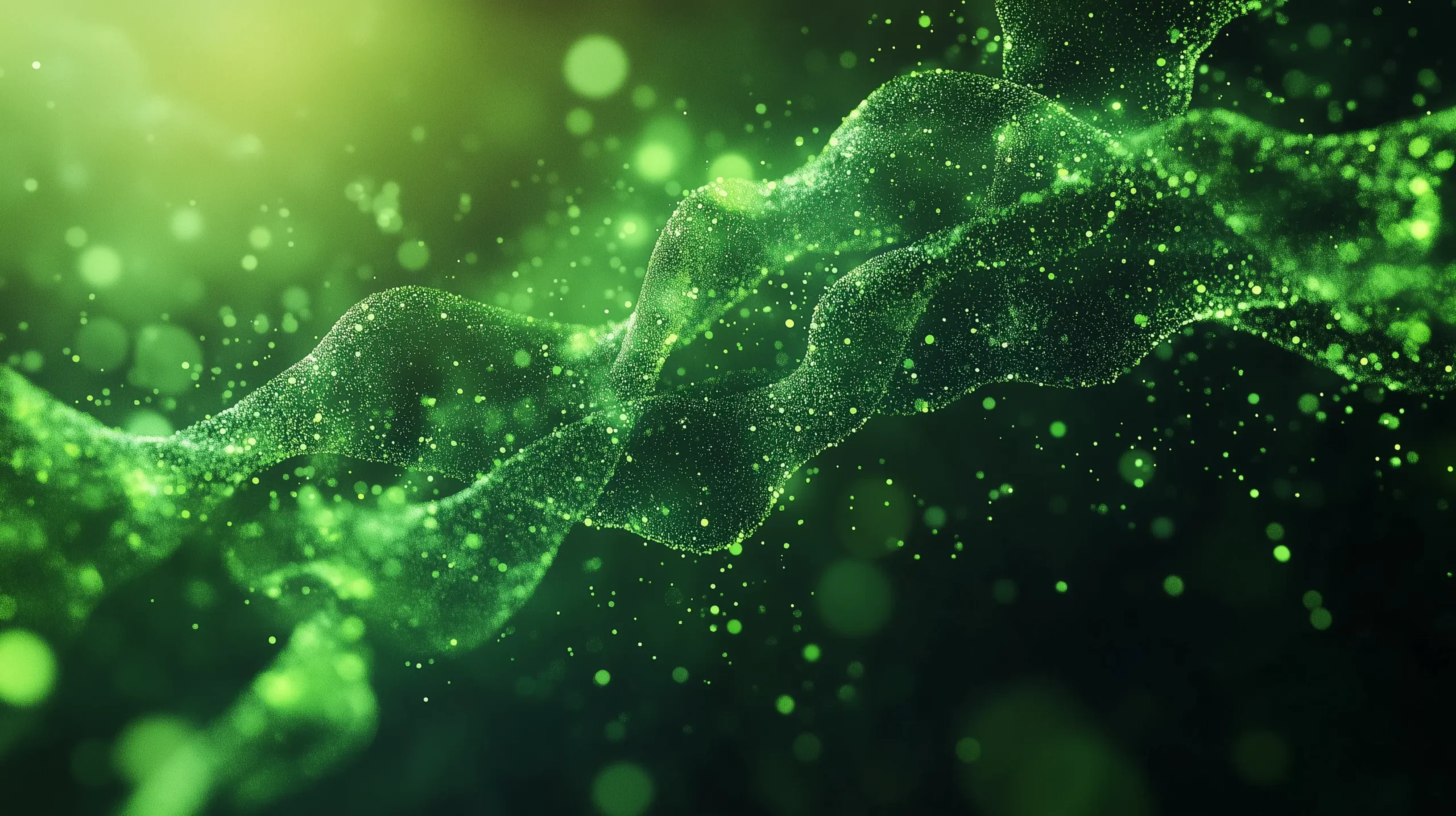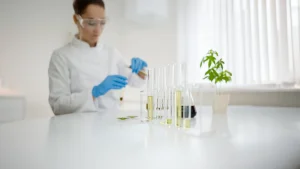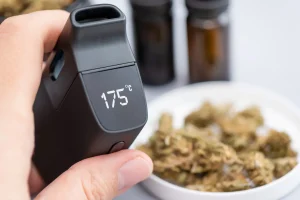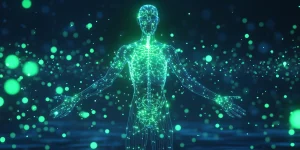Endocannabinoidsystem
Das Endocannabinoidsystem (ECS) ist ein körpereigenes Regulationssystem, bestehend aus Rezeptoren (zum Beispiel CB1 und CB2). Es sorgt für das innere Gleichgewicht (Homöostase) und beeinflusst vielfältige Funktionen wie Schmerz, Stimmung, Schlaf und Appetit. Seine Bestandteile sind nahezu im gesamten Körper verteilt.Auf der Suche nach der Andockstelle für das THC entdeckte man Anfang der 1990er Jahre zwei spezielle Rezeptoren: die Cannabinoid-Rezeptoren CB1 und CB2. Moleküle, die Ihr Körper selbst herstellt und die an diese Rezeptoren binden, nennt man Endocannabinoide. Zusammen mit den Enzymen, die für den Auf- und Abbau dieser Endocannabinoide zuständig sind, bilden diese Komponenten das Endocannabinoidsystem (ECS)¹‚².
Was ist das Endocannabinoidsystem (ECS)?
Das Endocannabinoidsystem (ECS) ist ein komplexes Regulationssystem in unserem Körper, das aus körpereigenen Cannabinoiden (Endocannabinoiden), spezifischen Rezeptoren (CB1 und CB2) und Enzymen besteht. Es spielt eine entscheidende Rolle bei der Aufrechterhaltung des inneren Gleichgewichts (Homöostase)8 und beeinflusst dabei eine Vielzahl von Funktionen wie Schmerzempfindung, Stimmung, Schlaf, Appetit und Immunreaktion.
Welche Aufgaben hat das Endocannabinoidsystem?
Das ECS ist ein lebenswichtiges System. Es hilft dabei, viele wichtige Körperfunktionen im Gleichgewicht (Homöostase) zu halten. Dazu gehören zum Beispiel Appetit, Energiehaushalt, Schmerzempfinden, Stimmung, Gedächtnis, Körpertemperatur und Immunreaktionen³. Diese zentrale Rolle könnte erklären, warum Cannabisprodukte im Rahmen einer ärztlich begleiteten Therapie bei unterschiedlichen Symptomen unterstützend eingesetzt werden können.
Die zwei Haupt-Rezeptoren des ECS, CB1 und CB2, gehören zur Familie der G-Protein-gekoppelten Rezeptoren. Werden sie aktiviert, lösen sie Signalketten in den Zellen aus. Sie unterscheiden sich aber in ihrer Verteilung im Körper und ihrer Funktion. Beide Rezeptortypen kommen im gesamten Körper vor. CB1-Rezeptoren finden sich besonders dicht im zentralen Nervensystem (ZNS). CB2-Rezeptoren befinden sich hauptsächlich auf Zellen des Immunsystems. Ihre Anzahl kann bei Gewebeverletzungen oder Entzündungen ansteigen²‚⁴.
Wo befinden sich die Cannabinoid-Rezeptoren (CB1 und CB2) im Körper?

Das Endocannabinoidsystem (ECS) ist nahezu im gesamten Körper vorhanden. Seine Hauptbestandteile, die Cannabinoid-Rezeptoren (CB1 und CB2), sind unterschiedlich verteilt:
- CB1-Rezeptoren finden sich vorwiegend im Gehirn und im zentralen Nervensystem, aber auch in geringerer Konzentration in anderen Organen wie dem Darm. Sie sind an der Regulierung von Schmerz, Stimmung, Appetit und Gedächtnis beteiligt.
- CB2-Rezeptoren sind hauptsächlich auf Zellen des Immunsystems und in peripheren Organen wie Haut, Muskeln und Knochen lokalisiert. Sie spielen eine Rolle bei Entzündungsreaktionen und Immunantworten.
Darüber hinaus umfasst das ECS die körpereigenen Cannabinoide (Endocannabinoide) und Enzyme, die diese produzieren und abbauen, was seine weitreichende Wirkung auf verschiedene Körperfunktionen erklärt.
Körpereigene Cannabinoide – Endocannabinoide
Die zuerst entdeckten und am besten erforschten körpereigenen Cannabinoide (Endocannabinoide) sind Anandamid (AEA) und 2-Arachidonoylglycerol (2-AG). Der Name Anandamid leitet sich vom Sanskrit-Wort ‚Ananda‘ ab, was ‚Glückseligkeit‘ bedeutet. AEA bindet und aktiviert hauptsächlich CB1-Rezeptoren, während 2-AG beide Rezeptortypen (CB1 und CB2) etwa gleich stark aktiviert. Spezifische Enzyme bauen diese körpereigenen Cannabinoide wieder ab: FAAH ist für AEA zuständig, MAGL für 2-AG¹‚⁴.
Wie interagieren THC und CBD mit den Rezeptoren?
Die pflanzlichen Haupt-Cannabinoide THC und CBD interagieren unterschiedlich mit den CB1- und CB2-Rezeptoren. THC bindet an beide Rezeptoren, jedoch stärker an den CB-1 Rezeptor und aktiviert sie. CBD hingegen bindet nur sehr schwach an die primären (‚orthosterischen‘) Bindungsstellen von CB1 und CB2. Dafür bindet CBD stärker an einer anderen, modulierenden (‚allosterischen‘) Stelle des CB1-Rezeptors. Dadurch kann es beeinflussen, wie gut andere Moleküle – einschließlich Ihrer körpereigenen Endocannabinoide und THC – an den CB1-Rezeptor binden⁵. Sowohl Endocannabinoide als auch Phyto-Cannabinoide entfalten ihre Wirkung aber nicht nur über CB1 und CB2, sondern auch durch die Interaktion mit weiteren Rezeptorsystemen im Körper. Wenn Sie tiefer einsteigen möchten: Die Quellenangaben am Ende listen dazu passende wissenschaftliche Artikel auf³‚⁴‚⁶.
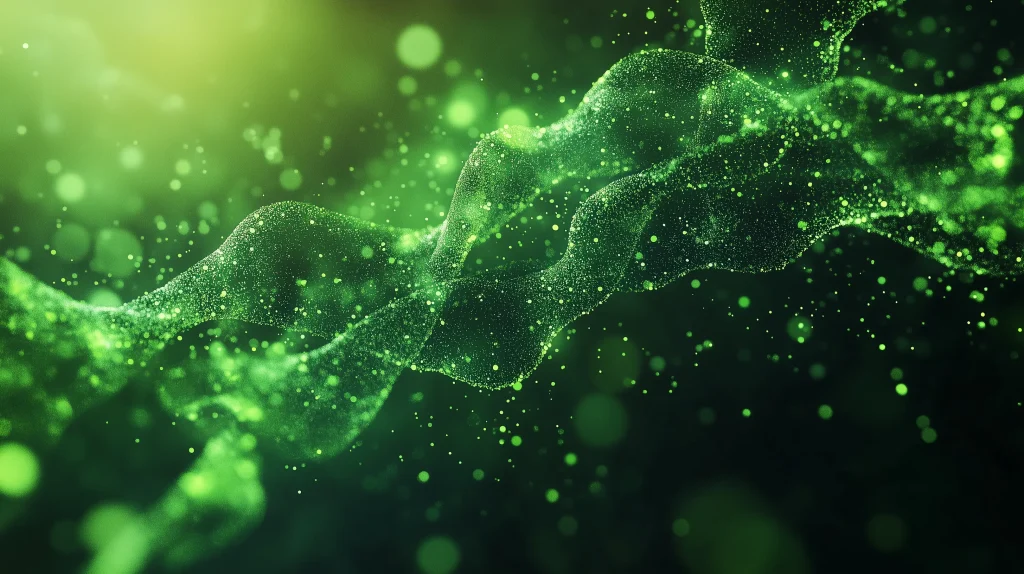
Was ist der Entourage-Effekt?
Neben den Haupt-Cannabinoiden THC und CBD enthält die Cannabispflanze viele weitere Substanzen, darunter seltenere Cannabinoide sowie Terpene und Flavonoide. Es wird angenommen, dass diese Komponenten ebenfalls zur Gesamtwirkung beitragen und sich im Zusammenspiel gegenseitig beeinflussen könnten – ein Konzept, das als ‚Entourage-Effekt‘ bekannt ist⁷. Die genauen Wirkmechanismen dieser Begleitstoffe sind jedoch noch wenig erforscht. Weitere Forschung ist notwendig, um ihr Potenzial und Zusammenspiel vollständig zu verstehen.
Häufig gestellte Fragen
Was ist das Endocannabinoidsystem (ECS)?
Das Endocannabinoidsystem (ECS) ist ein komplexes, körpereigenes Regulationssystem. Es besteht aus Cannabinoid-Rezeptoren (CB1, CB2), körpereigenen Cannabinoiden (Endocannabinoide) und Enzymen, die für Auf- und Abbau zuständig sind1,2.
Welche Aufgaben erfüllt das Endocannabinoidsystem im Körper?
Das ECS sorgt für das innere Gleichgewicht (Homöostase) und steuert zahlreiche Körperfunktionen wie Schmerzempfinden, Stimmung, Schlaf, Appetit, Gedächtnis und Immunantworten3,4.
Welche Rolle spielen die Cannabinoid-Rezeptoren CB1 und CB2?
CB1- und CB2-Rezeptoren sind die zentralen Schaltstellen des ECS. Sie empfangen Signale von Endocannabinoiden und lösen spezifische Zellreaktionen aus – CB1 vor allem im zentralen Nervensystem, CB2 überwiegend im Immunsystem1,2.
Wo befinden sich die CB1- und CB2-Rezeptoren im menschlichen Körper?
CB1-Rezeptoren finden sich hauptsächlich im Gehirn und zentralen Nervensystem, aber auch im Darm. CB2-Rezeptoren sitzen überwiegend auf Immunzellen und in Organen wie Haut, Muskeln und Knochen2,4.
Was sind Endocannabinoide?
Endocannabinoide sind körpereigene Moleküle, die ähnlich wirken wie die Cannabinoide aus der Cannabispflanze. Sie binden an CB1- und CB2-Rezeptoren und regulieren viele Körperfunktionen1,4.
Welche Endocannabinoide sind besonders bekannt?
Die wichtigsten Endocannabinoide sind Anandamid (AEA) und 2-Arachidonoylglycerol (2-AG). Anandamid aktiviert vor allem CB1-Rezeptoren, während 2-AG beide Rezeptortypen anspricht1.
Wie werden Endocannabinoide im Körper abgebaut?
Spezielle Enzyme bauen Endocannabinoide ab: FAAH ist für Anandamid (AEA), MAGL für 2-AG zuständig. Sie beenden die Wirkung nach Bedarf1.
Wie wirken THC und CBD im Endocannabinoidsystem?
THC bindet direkt an CB1- und CB2-Rezeptoren und aktiviert diese. CBD bindet nur schwach an die klassischen Bindungsstellen, moduliert aber die Wirkung anderer Cannabinoide und wirkt an weiteren Rezeptorsystemen5.
Worin unterscheiden sich die Bindungseigenschaften von THC und CBD an die Rezeptoren?
THC dockt vor allem an CB1-Rezeptoren und aktiviert sie. CBD bindet schwach, wirkt aber an einer anderen (allosterischen) Stelle und beeinflusst, wie andere Moleküle wie THC oder körpereigene Cannabinoide an CB1 binden5.
Welche weiteren Wirkstoffe aus der Cannabispflanze wirken auf das ECS?
Neben THC und CBD enthält die Cannabispflanze viele weitere Cannabinoide sowie Terpene und Flavonoide. Diese Stoffe können ebenfalls mit dem ECS interagieren und die Gesamtwirkung beeinflussen6,7.
Was ist der Entourage-Effekt?
Der Entourage-Effekt beschreibt das Zusammenspiel verschiedener Cannabinoide, Terpene und Flavonoide in der Cannabispflanze. Es wird angenommen, dass sie sich gegenseitig in ihrer Wirkung verstärken oder modifizieren7.
Welche Funktionen hat das ECS bei Schmerz, Stimmung und Appetit?
Das ECS reguliert unter anderem Schmerzempfinden, Stimmungslage, Appetit, Schlaf und Gedächtnis. Ein ausgeglichenes ECS trägt zum Wohlbefinden bei3,4.
Gibt es Unterschiede in der Wirkung von CB1- und CB2-Rezeptoren?
Ja, CB1-Rezeptoren sind hauptsächlich für Prozesse im Gehirn wie Gedächtnis, Schmerz und Stimmung verantwortlich. CB2-Rezeptoren beeinflussen vor allem Immunreaktionen und Entzündungen2,4.
Warum ist das ECS für die Wirkung von medizinischem Cannabis relevant?
Die therapeutische Wirkung von medizinischem Cannabis beruht zu einem großen Teil auf der Interaktion mit dem ECS – insbesondere über die CB1- und CB2-Rezeptoren.
Kann eine Dysfunktion im ECS Krankheiten verursachen?
Eine gestörte Funktion des ECS wird mit verschiedenen Erkrankungen wie chronischen Schmerzen, psychischen Störungen oder Entzündungen in Verbindung gebracht3,4.
Wie beeinflusst das ECS das Immunsystem?
CB2-Rezeptoren sind auf Immunzellen weit verbreitet. Sie steuern Immunantworten und können Entzündungsreaktionen abschwächen oder fördern2.
Welche Rolle spielen Enzyme im Endocannabinoidsystem?
Enzyme wie FAAH und MAGL sorgen dafür, dass Endocannabinoide nach ihrer Wirkung schnell wieder abgebaut werden, um das Gleichgewicht im Körper zu erhalten1.
Wie ist die Homöostase mit dem ECS verbunden?
Das ECS unterstützt die Homöostase, also das innere Gleichgewicht des Körpers, indem es verschiedene physiologische Prozesse wie Temperatur, Energiehaushalt, Appetit und Immunreaktionen reguliert3.
Was bedeutet allosterische Modulation bei CBD?
CBD wirkt an einer allosterischen Bindungsstelle des CB1-Rezeptors. Das bedeutet, es beeinflusst die Wirkung anderer Moleküle am Rezeptor, ohne selbst direkt die klassische Aktivierung auszulösen5.
Welche wissenschaftlichen Quellen gibt es zum Endocannabinoidsystem?
Ausführliche wissenschaftliche Artikel und Übersichten finden Sie beispielsweise bei Howlett & Abood (2017), Zou & Kumar (2018), Russo (2011) oder im International Journal of Molecular Sciences1,2,7.
Quellenangaben
- Howlett, A. C. & Abood, M. E. CB1 and CB2 Receptor Pharmacology. Advances in Pharmacology 80, 169–206 (2017).
- Zou, S. & Kumar, U. Cannabinoid Receptors and the Endocannabinoid System: Signaling and Function in the Central Nervous System. International journal of molecular sciences 19, (2018).
- Lowe, H. et al. The endocannabinoid system: A potential target for the treatment of various diseases. International Journal of Molecular Sciences vol. 22 (2021).
- Lu, H. C. & MacKie, K. An introduction to the endogenous cannabinoid system. Biological Psychiatry vol. 79 516–525 (2016).
- Zagzoog, A. et al. In vitro and in vivo pharmacological activity of minor cannabinoids isolated from Cannabis sativa. Scientific Reports 10, (2020).
- Morales, P., Hurst, D. P. & Reggio, P. H. Molecular Targets of the Phytocannabinoids-A Complex Picture. Progress in the chemistry of organic natural products 103, 103 (2017).
- Russo, E. B. Taming THC: Potential cannabis synergy and phytocannabinoid-terpenoid entourage effects. British Journal of Pharmacology vol. 163 1344–1364 (2011).
- Müller-Vahl, K. R., & Grotenhermen, F. (Eds.). (2019). Cannabis und Cannabinoide: in der Medizin. MWV.
